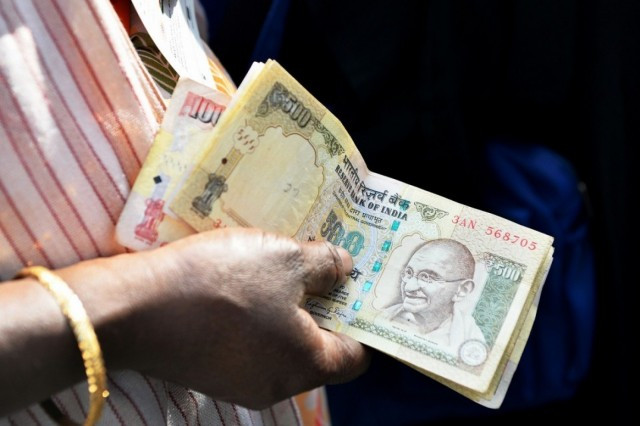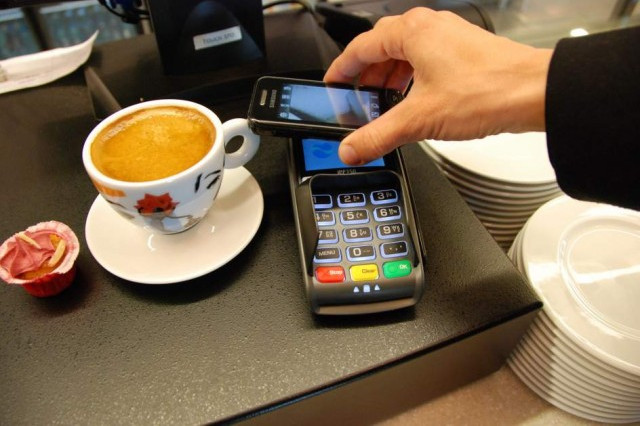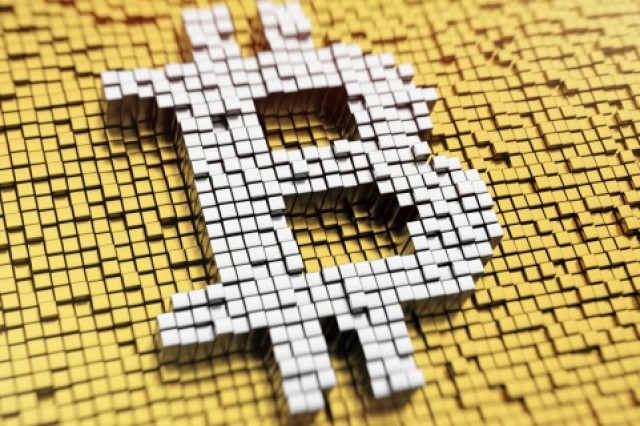There are numerous studies about money. This precious commodity of society has been one of the greatest inventions of mankind since ancient peoples decided to stop being nomadic and become sedentary: it was no longer possible to meet needs based on the exchange of goods, and it became necessary to establish something that acted as unit of measure, means of change and reserve of value.
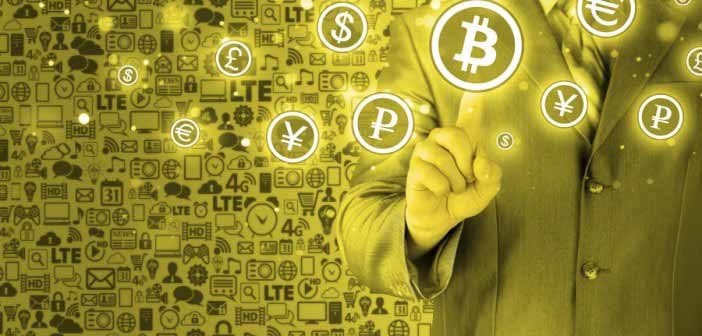
Over time, money took on a variety of forms, up to the current fiduciary money, issued by the respective central banks of countries, whose value is based on the credibility of a public asking the same of the monetary authority.
It is because of the need for public confidence that central banks have to pursue monetary policies in line with the objective of maintaining the value of the currency stable, otherwise, money begins to lose its value (or looking from the point of view of goods, they begin to increase the amount of domestic currency that has to be delivered in exchange for them, a phenomenon known as inflation).
When the value of money becomes unstable (particularly if the loss is continuous) it makes the notes and coins and the deposits considered transactional money begin to lose their basic functions: the first that it is abandoned as a store of value, and that a monetary unit today is worth more than tomorrow, the reason why it is not possible to transfer the value of the money in time. With high inflation rates, it also loses its remaining functions, as some prices start to be fixed in other currencies and the domestic currency printed by the corresponding central bank is no longer accepted.
In a globalised economy such as the present one, capital movements began to introduce strong instabilities in the demand for money, the reason why it was complicated for the central banks to continue pursuing monetary policy based on monetary aggregates, the reason why we migrated to the fixing of reference interest rates, in many cases based on Taylor's rule (1993) (1). In this, he proposes that the nominal interest rate has to respond to the gap between the real inflation rates of the objective of inflation, and the gap between real GDP and the effective GDP potential.
Cryptocurrencies are a kind of "private" money, whose stock is not controlled by any central bank, and whose price depends on market supply and demand
Fortunately, most countries have understood the scourge of the inflationary phenomenon, achieving a sanity in the management of their monetary policy, based on the credibility and independence of their central banks - exceptions are the countries such as Venezuela, South Sudan, Syria, Argentina and Suriname, which were in the "top 5" of the world's most inflationary economies during 2016, reaching + 700%, 371%, 47.7%, 42.8% and 39%, respectively.
However, today we are in a transition -slow but sustained- from fiduciary money to cryptocurrency, which emerged in response to the financial monetary crises caused by the acceleration of money production by central banks, which can be taken into consideration as an unlimited development of debt that is multiplied through commercial banks and the fractional reserve system.
Cryptocurrencies and their evolution
Cryptocurrencies -the (although imperfect) substitute for money issued by the monetary authority- are a kind of "private" money, whose stock is not controlled by any central bank, and whose price depends on market supply and demand. While the idea of this new decentralised currency that cryptography uses as a means of control was raised by Wei Dai in 1998, as recently as 2009 the first cryptocurrency, Bitcoin, was created.

Within this category, Bitcoin is not only the first to start operating, but also the most well-known. There are also Litecoin, Ripple or Dogecoin, among others, and they focus on the idea that their system of encryption of the currency is superior to that of traditional banking.
The superiority of this "new money" is based on the independence from the economic system in which it operates: it only has value to the extent that the market supports it, which is formed by a community that requires it, and a shortage of it, since the amount of a programmable currency is limited, and we estimate that they will be created until 2033, a year in which we expect to reach the immovable limit of 21 million Bitcoins in circulation.
We should note that, although they have been on the market for eight years, they have started to attract interest in 2011, particularly since in April 2013, the month in which Bitcoin skyrocketed. On May 24the this year, Bitcoin reached its highest historical price, 2,387 USD, and as can be seen in the following graph, its rise shows an exponential trend.
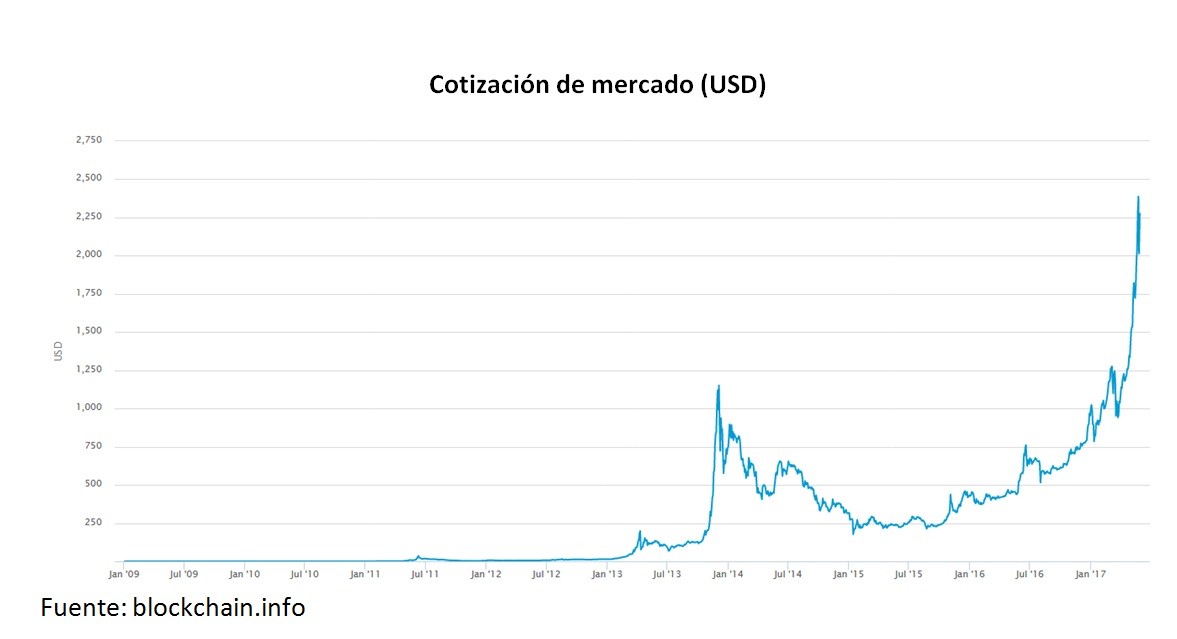
This upward trend explains that today it is one of the most profitable forms of savings, since fiduciary money loses value day by day in all countries, while this "new money" not only reduces its value but the growth rate in recent years has been abysmal: while an ounce of gold took 37 years to reach its current value, Bitcoin only took three years and stands now at around $2,400, double what gold is trading at today.
Final considerations
While it seems that criptomonedas are with us to stay, there are as yet still few establishments that accept it as a means of payment (they can be used through electronic means or debit cards).
However, throughout the global spectrum we can observe different decisions of the governments regarding this financial instrument. While Germany was the first country to recognize Bitcoin as a "monetary unit" and "private money" in August 2013, and since April 1st of this year, Japan legalized the crypto-net as a method of payment, Thailand and China were the first countries to prohibit the use of virtual currency at the state and banking levels, to continue to control operations and the flow of capital (although private banks can use it at their own risk).
Also, according to the IMF's precepts it is not considered a currency because it does not have the backing of the central banks of other countries. In this way, the international financial system is detached from the responsibility for the use of cryptocurrencies, transferring all its risk to its user. However, it is significant to note that in the case of currencies, even though the IMF and central banks have margin to intervene in the market, the final risk is also assumed by the user.
On the other hand, given that it is "electronic money", users of this currency could suffer losses of asset due to confidence shocks (in the security protocol or currency), exchange rate volatility, or issues related to computer security, such as software errors and computer viruses, among others.
If criptomonedas are with us to stay, there are as yet still few establishments that accept it as a means of payment (they can be used through electronic means or debit cards)
Finally, the anonymity of the use of cryptocurrencies can simplify the buying and selling of illegal goods, money laundering and tax evasion.
However, when we analyze the countries that consider them legal or illegal, we note the close relationship between the level of development of each of these and the acceptance of private money as a method of payment: while in developed countries such operations are more controlled, and therefore the crypto-notes are accepted; in less-developed countries and with a larger black and illegal economy, they have been banned. Therefore, these institutional issues that define the legality or not of electronic money come before the actual use of electronic money, and has to do more with fundamental issues that the countries themselves have to be responsible for resolving, regardless of the money they use.
(1) Taylor, John B. (1993) "Discretion versus Policy Rules in Practice," Carnegie-Rochester Conference Series on Public Policy, 39, pp.195-214.



